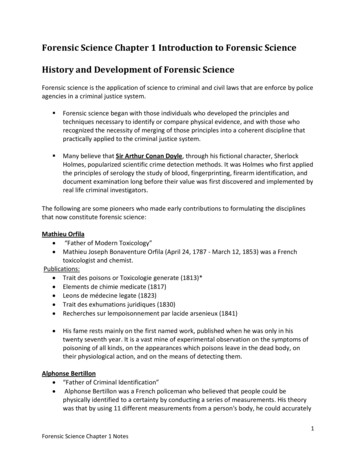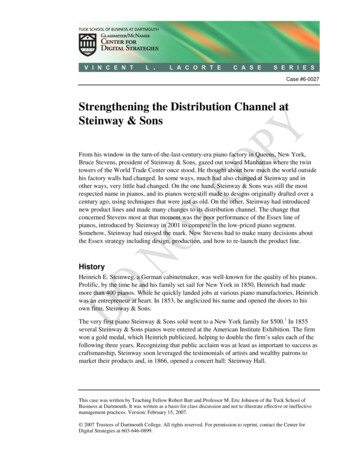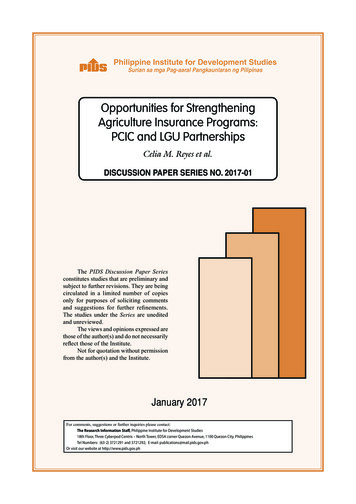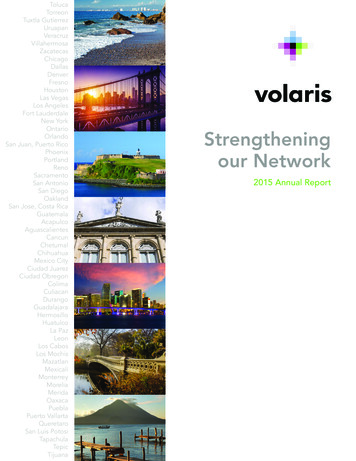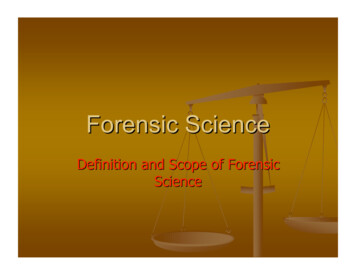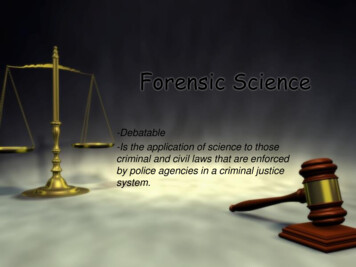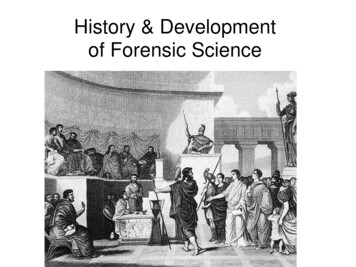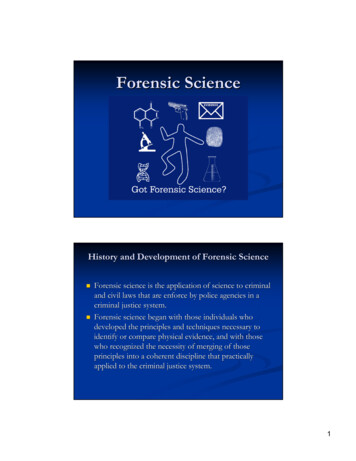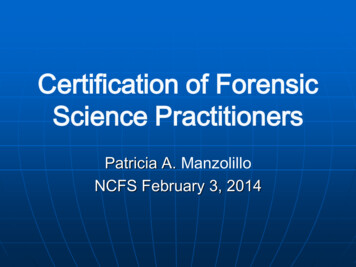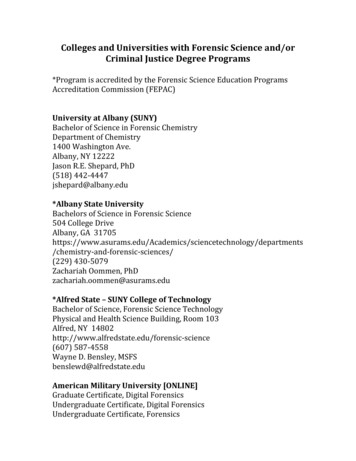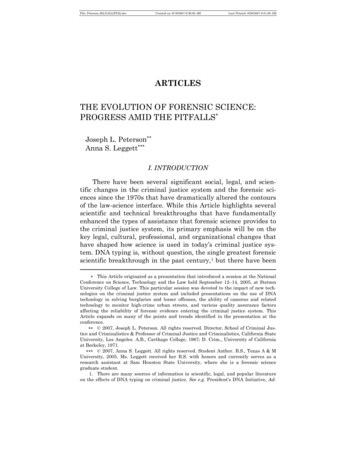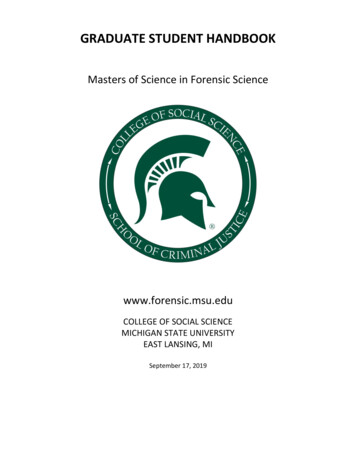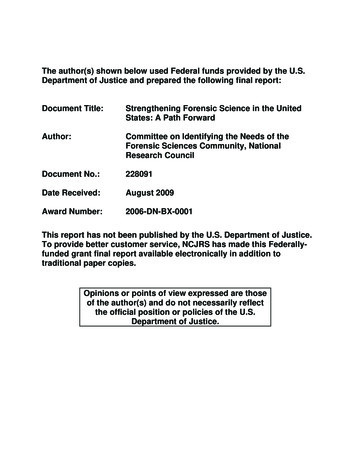
Transcription
The author(s) shown below used Federal funds provided by the U.S.Department of Justice and prepared the following final report:Document Title:Strengthening Forensic Science in the UnitedStates: A Path ForwardAuthor:Committee on Identifying the Needs of theForensic Sciences Community, NationalResearch CouncilDocument No.:228091Date Received:August 2009Award Number:2006-DN-BX-0001This report has not been published by the U.S. Department of Justice.To provide better customer service, NCJRS has made this Federallyfunded grant final report available electronically in addition totraditional paper copies.Opinions or points of view expressed are thoseof the author(s) and do not necessarily reflectthe official position or policies of the U.S.Department of Justice.
http://www.nap.edu/catalog/12589.htmlWe ship printed books within 1 business day; personal PDFs are available immediately.Strengthening Forensic Science in the UnitedStates: A Path ForwardCommittee on Identifying the Needs of the ForensicSciences Community, National Research CouncilISBN: 0-309-13131-6, 352 pages, 6 x 9, (2009)This PDF is available from the National Academies Press at:http://www.nap.edu/catalog/12589.htmlVisit the National Academies Press online, the authoritative source for all booksfrom the National Academy of Sciences, the National Academy of Engineering,the Institute of Medicine, and the National Research Council: Download hundreds of free books in PDF Read thousands of books online for free Explore our innovative research tools – try the “Research Dashboard” now! Sign up to be notified when new books are published Purchase printed books and selected PDF filesThank you for downloading this PDF. If you have comments, questions orjust want more information about the books published by the NationalAcademies Press, you may contact our customer service department tollfree at 888-624-8373, visit us online, or send an email tofeedback@nap.edu.This book plus thousands more are available at http://www.nap.edu.Copyright National Academy of Sciences. All rights reserved.Unless otherwise indicated, all materials in this PDF File are copyrighted by the NationalAcademy of Sciences. Distribution, posting, or copying is strictly prohibited withoutwritten permission of the National Academies Press. Request reprint permission for this book.This document is a research report submitted to the U.S. Department of Justice. This report has notbeen published by the Department. Opinions or points of view expressed are those of the author(s)and do not necessarily reflect the official position or policies of the U.S. Department of Justice.
Strengthening Forensic Science in the United States: A Path THENINGFORENSICSCIENCEI N T H E U N I T E D S TAT E SA P A T H F O R WA R DCommittee on Identifying the Needs of the Forensic Science CommunityCommittee on Science, Technology, and LawPolicy and Global AffairsCommittee on Applied and Theoretical StatisticsDivision on Engineering and Physical SciencesThis document is a research report submitted to the U.S. Department of Justice. This report has notbeen published by the Department. Opinions or points of view expressed are those of the author(s)and do not necessarily reflect the official position or policies of the U.S. Department of Justice.Copyright National Academy of Sciences. All rights reserved.
Strengthening Forensic Science in the United States: A Path Forwardhttp://www.nap.edu/catalog/12589.htmlTHE NATIONAL ACADEMIES PRESS 500 Fifth Street, N.W. Washington, DC 20001NOTICE: The project that is the subject of this report was approved by the Governing Board of the National Research Council, whose members are drawn from thecouncils of the National Academy of Sciences, the National Academy of Engineering, and the Institute of Medicine. The members of the committee responsible forthe report were chosen for their special competences and with regard for appropriate balance.This study was supported by Contract No. 2006-DN-BX-0001 between the National Academy of Sciences and the National Institute of Justice. Any opinions,findings, conclusions, or recommendations expressed in this publication are those ofthe author(s) and do not necessarily reflect the views of the organizations or agenciesthat provided support for the project.Library of Congress Cataloging-in-Publication DataStrengthening forensic science in the United States : a path forward : summary/ Committee on Identifying the Needs of the Forensic Science Community,Committee on Science, Technology, and Law Policy and Global Affairs,Committee on Applied and Theoretical Statistics, Division on Engineering andPhysical Sciences.p. cm.Includes index.ISBN-13: 978-0-309-13135-3 (hardcover)ISBN-10: 0-309-13135-9 (hardcover)ISBN-13: 978-0-309-13131-5 (pbk.)ISBN-10: 0-309-13131-6 (pbk.)1. Forensic sciences—United States. 2. Criminal investigation—United States.3. Evidence, Criminal—United States. I. National Research Council (U.S.).Committee on Identifying the Needs of the Forensic Science Community. II.National Research Council (U.S.). Committee on Science, Technology, and LawPolicy and Global Affairs. III. National Research Council (U.S.). Committee onApplied and Theoretical Statistics.HV8073.S7347 2009363.250973—dc222009011443Additional copies of this report are available from the National Academies Press,500 Fifth Street, N.W., Lockbox 285, Washington, DC 20055; (800) 624-6242 or(202) 334-3313 (in the Washington metropolitan area); Internet, http://www.nap.edu.Copyright 2009 by the National Academy of Sciences. All rights reserved.Printed in the United States of AmericaThis document is a research report submitted to the U.S. Department of Justice. This report has notbeen published by the Department. Opinions or points of view expressed are those of the author(s)and do not necessarily reflect the official position or policies of the U.S. Department of Justice.Copyright National Academy of Sciences. All rights reserved.
Strengthening Forensic Science in the United States: A Path Forwardhttp://www.nap.edu/catalog/12589.htmlThe National Academy of Sciences is a private, nonprofit, self-perpetuating societyof distinguished scholars engaged in scientific and engineering research, dedicated tothe furtherance of science and technology and to their use for the general welfare.Upon the authority of the charter granted to it by the Congress in 1863, the Academy has a mandate that requires it to advise the federal government on scientificand technical matters. Dr. Ralph J. Cicerone is president of the National Academyof Sciences.The National Academy of Engineering was established in 1964, under the charterof the National Academy of Sciences, as a parallel organization of outstanding engineers. It is autonomous in its administration and in the selection of its members,sharing with the National Academy of Sciences the responsibility for advising thefederal government. The National Academy of Engineering also sponsors engineering programs aimed at meeting national needs, encourages education and research,and recognizes the superior achievements of engineers. Dr. Charles M. Vest is president of the National Academy of Engineering.The Institute of Medicine was established in 1970 by the National Academy ofSciences to secure the services of eminent members of appropriate professions inthe examination of policy matters pertaining to the health of the public. The Institute acts under the responsibility given to the National Academy of Sciences by itscongressional charter to be an adviser to the federal government and, upon its owninitiative, to identify issues of medical care, research, and education. Dr. Harvey V.Fineberg is president of the Institute of Medicine.The National Research Council was organized by the National Academy of Sciences in 1916 to associate the broad community of science and technology with theAcademy’s purposes of furthering knowledge and advising the federal government.Functioning in accordance with general policies determined by the Academy, theCouncil has become the principal operating agency of both the National Academyof Sciences and the National Academy of Engineering in providing services to thegovernment, the public, and the scientific and engineering communities. The Council is administered jointly by both Academies and the Institute of Medicine. Dr.Ralph J. Cicerone and Dr. Charles M. Vest are chair and vice chair, respectively, ofthe National Research Council.www.national-academies.orgThis document is a research report submitted to the U.S. Department of Justice. This report has notbeen published by the Department. Opinions or points of view expressed are those of the author(s)and do not necessarily reflect the official position or policies of the U.S. Department of Justice.Copyright National Academy of Sciences. All rights reserved.
Strengthening Forensic Science in the United States: A Path Forwardhttp://www.nap.edu/catalog/12589.htmlThis document is a research report submitted to the U.S. Department of Justice. This report has notbeen published by the Department. Opinions or points of view expressed are those of the author(s)and do not necessarily reflect the official position or policies of the U.S. Department of Justice.Copyright National Academy of Sciences. All rights reserved.
Strengthening Forensic Science in the United States: A Path tee on Identifying the Needs of theForensic Science CommunityHARRY T. EDWARDS, (Co-chair), Judge, U.S. Court of Appeals for theDistrict of Columbia CircuitCONSTANTINE GATSONIS, (Co-chair), Director, Center for StatisticalSciences, Brown UniversityMARGARET A. BERGER, Suzanne J. and Norman Miles Professor ofLaw, Brooklyn Law SchoolJOE S. CECIL, Project Director, Program on Scientific and TechnicalEvidence, Federal Judicial CenterM. BONNER DENTON, Professor of Chemistry, University of ArizonaMARCELLA F. FIERRO, Medical Examiner of Virginia (ret.)KAREN KAFADAR, Rudy Professor of Statistics and Physics, IndianaUniversityPETE M. MARONE, Director, Virginia Department of Forensic ScienceGEOFFREY S. MEARNS, Dean, Cleveland-Marshall College of Law,Cleveland State UniversityRANDALL S. MURCH, Associate Director, Research ProgramDevelopment, Virginia Polytechnic Institute and State UniversityCHANNING ROBERTSON, Ruth G. and William K. Bowes Professor,Dean of Faculty and Academic Affairs, and Professor, Department ofChemical Engineering, Stanford UniversityMARVIN E. SCHECHTER, AttorneyROBERT SHALER, Director, Forensic Science Program, Professor,Biochemistry and Molecular Biology Department, Eberly College ofScience, The Pennsylvania State UniversityJAY A. SIEGEL, Professor, Forensic and Investigative Sciences Program,Indiana University-Purdue UniversitySARGUR N. SRIHARI, SUNY Distinguished Professor, Department ofComputer Science and Engineering and Director, Center of Excellencefor Document Analysis and Recognition (CEDAR), University atBuffalo, State University of New YorkSHELDON M. WIEDERHORN (NAE), Senior NIST Fellow, NationalInstitute of Standards and TechnologyROSS E. ZUMWALT, Chief Medical Examiner, Office of the MedicalExaminer of the State of New Mexico This document is a research report submitted to the U.S. Department of Justice. This report has notbeen published by the Department. Opinions or points of view expressed are those of the author(s)and do not necessarily reflect the official position or policies of the U.S. Department of Justice.Copyright National Academy of Sciences. All rights reserved.
Strengthening Forensic Science in the United States: A Path NNE-MARIE MAZZA, Study DirectorSCOTT T. WEIDMAN, Director, Board on Mathematical Sciences andTheir ApplicationsJOHN SISLIN, Program Officer, Board on Higher Education andWorkforceDAVID PADGHAM, Program Officer, Computer Science andTelecommunications Board (until 5/08)STEVEN KENDALL, Senior Program AssociateKATIE MAGEE, Senior Program Assistant (until 9/07)KATHI E. HANNA, Consultant WriterSARA D. MADDOX, EditorROBIN ACKERMAN, Christine Mirzayan Science and TechnologyPolicy FellowGEMAYEL JEAN-PAUL, Christine Mirzayan Science and TechnologyPolicy FellowJOHNALYN D. LYLES, Christine Mirzayan Science and TechnologyPolicy FellowSANDRA OTTENSMANN, Christine Mirzayan Science and TechnologyPolicy FellowDEIRDRE PARSONS, Christine Mirzayan Science and Technology PolicyFellowSARAH RYKER, Christine Mirzayan Science and Technology PolicyFellowSUNBIN SONG, Christine Mirzayan Science and Technology PolicyFellowviThis document is a research report submitted to the U.S. Department of Justice. This report has notbeen published by the Department. Opinions or points of view expressed are those of the author(s)and do not necessarily reflect the official position or policies of the U.S. Department of Justice.Copyright National Academy of Sciences. All rights reserved.
Strengthening Forensic Science in the United States: A Path tee on Science, Technology, and LawDONALD KENNEDY (NAS/IOM), (Co-chair), President Emeritusand Bing Professor of Environmental Science Emeritus, StanfordUniversity; Emeritus Editor-in-Chief, ScienceRICHARD A. MERRILL (IOM), (Co-chair), Daniel Caplin Professor ofLaw Emeritus, University of Virginia Law SchoolFREDERICK R. ANDERSON, JR., Partner, McKenna, Long, & AldridgeLLPMARGARET A. BERGER, Suzanne J. and Norman Miles Professor ofLaw, Brooklyn Law SchoolARTHUR I. BIENENSTOCK, Special Assistant to the President forSLAC and Federal Research Policy, Stanford UniversityBARBARA E. BIERER, Senior Vice President for Research, Brigham andWomen’s HospitalELIZABETH H. BLACKBURN (NAS/IOM), Morris Herzstein Professorof Biology and Physiology, Department of Biochemistry andBiophysics, University of California, San FranciscoJOE S. CECIL, Project Director, Program on Scientific and TechnicalEvidence, Federal Judicial CenterRICHARD F. CELESTE, President, Colorado CollegeJOEL E. COHEN (NAS), Abby Rockefeller Mauzé Professor and Head,Laboratory of Populations, The Rockefeller University and ColumbiaUniversityKENNETH W. DAM, Max Pam Professor Emeritus of American andForeign Law and Senior Lecturer, University of Chicago Law SchoolROCHELLE COOPER DREYFUSS, Pauline Newman Professor of Lawand Director, Engelberg Center on Innovation Law and Policy, NewYork University School of LawALICE P. GAST (NAE), President, Lehigh UniversityLAWRENCE O. GOSTIN (IOM), Associate Dean for Research andAcademic Programs, Linda D. and Timothy J. O’Neill Professorof Global Health Law, Georgetown University; Professor of PublicHealth, The Johns Hopkins UniversityGARY W. HART, Wirth Chair Professor, School of Public Affairs,University of Colorado, DenverBENJAMIN W. HEINEMAN, JR., Senior Fellow, Harvard Law Schooland Harvard Kennedy School of GovernmentDAVID BROCK HORNBY, Judge, U.S. District Court, District of MaineDAVID KORN (IOM), Vice Provost for Research, Harvard UniversityRICHARD A. MESERVE (NAE), President, Carnegie Institution ofWashingtonviiThis document is a research report submitted to the U.S. Department of Justice. This report has notbeen published by the Department. Opinions or points of view expressed are those of the author(s)and do not necessarily reflect the official position or policies of the U.S. Department of Justice.Copyright National Academy of Sciences. All rights reserved.
Strengthening Forensic Science in the United States: A Path Forwardhttp://www.nap.edu/catalog/12589.htmlDUNCAN T. MOORE (NAE), Professor, The Institute of Optics,University of RochesterALAN B. MORRISON, Visiting Professor, Washington College of Law,American UniversityHARRIET RABB, Vice President and General Counsel, RockefellerUniversityPAUL D. RHEINGOLD, Senior Partner, Rheingold, Valet, Rheingold,Shkolnik & McCartney LLPBARBARA ROTHSTEIN, Director, Federal Judicial CenterJONATHAN M. SAMET (IOM), Founding Director, Institute forGlobal Health and Chairman, Department of Preventive Medicine,University of Southern CaliforniaDAVID S. TATEL, Judge, U.S. Court of Appeals for the District ofColumbia CircuitStaffANNE-MARIE MAZZA, DirectorSTEVEN KENDALL, Senior Program AssociateviiiThis document is a research report submitted to the U.S. Department of Justice. This report has notbeen published by the Department. Opinions or points of view expressed are those of the author(s)and do not necessarily reflect the official position or policies of the U.S. Department of Justice.Copyright National Academy of Sciences. All rights reserved.
Strengthening Forensic Science in the United States: A Path tee on Applied and Theoretical StatisticsKAREN KAFADAR, (Chair), Rudy Professor of Statistics and Physics,Indiana UniversityAMY BRAVERMAN, MISR Co-Investigator, Statistics and Data Analysis,Earth and Space Sciences Division, Jet Propulsion LaboratoryCONSTANTINE GATSONIS, Director, Center for Statistical Sciences,Brown UniversityMICHAEL GOODCHILD (NAS), Professor, Department of Geography,University of California, Santa BarbaraKATHRYN B. LASKEY, Professor, Department of Systems Engineeringand Operations Research, George Mason UniversityMICHAEL LESK (NAE), Professor, Library and Information Sciences,Rutgers UniversityTHOMAS A. LOUIS, Professor, Department of Biostatistics, BloombergSchool of Public Health, The Johns Hopkins UniversityMICHAEL A. NEWTON, Professor, Department of Biostatistics andMedical Informatics, University of Wisconsin, MadisonMICHAEL L. STEIN, Professor, Department of Statistics, The Universityof ChicagoStaffSCOTT WEIDMAN, DirectorNEAL GLASSMAN, Senior Program OfficerBARBARA WRIGHT, Administrative AssistantixThis document is a research report submitted to the U.S. Department of Justice. This report has notbeen published by the Department. Opinions or points of view expressed are those of the author(s)and do not necessarily reflect the official position or policies of the U.S. Department of Justice.Copyright National Academy of Sciences. All rights reserved.
Strengthening Forensic Science in the United States: A Path Forwardhttp://www.nap.edu/catalog/12589.htmlThis document is a research report submitted to the U.S. Department of Justice. This report has notbeen published by the Department. Opinions or points of view expressed are those of the author(s)and do not necessarily reflect the official position or policies of the U.S. Department of Justice.Copyright National Academy of Sciences. All rights reserved.
Strengthening Forensic Science in the United States: A Path ledgmentsACKNOWLEDGMENT OF PRESENTERSThe committee gratefully acknowledges the contributions of the following individuals who made thoughtful presentations before it:Chris Asplen, Gordon Thomas Honeywell Government Affairs; PeterD. Barnett, Forensic Science Associates; Richard E. Bisbing, McCroneAssociates, Inc., and Scientific Working Group on Materials Analysis(SWGMAT); Joseph P. Bono, U.S. Secret Service; Michael R. Bromwich,Fried, Frank, Harris, Shriver & Jacobson LLP; Bruce Budowle, FederalBureau of Investigation; James Burans, U.S. Department of HomelandSecurity; Thomas Cantwell, U.S. Department of Defense; Larry Chelko,U.S. Army Criminal Investigation Laboratory; John Collins, DuPageCounty Sheriff’s Office Crime Laboratory; Charles Cooke, Office of theDirector of National Intelligence; Robin Cotton, Boston University Schoolof Medicine; Joseph A. DiZinno, Federal Bureau of Investigation; JamesDowns, National Association of Medical Examiners and Consortium ofForensic Science Organizations and Georgia Bureau of Investigation; ItielDror, University of Southampton; Arthur Eisenberg, Forensic Quality Services; Barry A. J. Fisher, Los Angeles County Sheriff’s Department; EricFriedberg, Stroz Friedberg, LLC; Robert E. Gaensslen, University of Illinois at Chicago; Brandon L. Garrett, University of Virginia; Michael D.Garris, National Institute of Standards and Technology; Ed German, U.S.Army (ret.); Paul C. Giannelli, Case Western Reserve University School ofLaw; Bruce A. Goldberger, American Academy of Forensic Sciences; HankxiThis document is a research report submitted to the U.S. Department of Justice. This report has notbeen published by the Department. Opinions or points of view expressed are those of the author(s)and do not necessarily reflect the official position or policies of the U.S. Department of Justice.Copyright National Academy of Sciences. All rights reserved.
Strengthening Forensic Science in the United States: A Path NOWLEDGMENTSGreely, Stanford University; Barbara Guttman, National Institute of Standards and Technology; David W. Hagy, U.S. Department of Justice; RandyHanzlick, Fulton County Medical Examiner’s Center and Emory UniversitySchool of Medicine; Carol Henderson, National Clearinghouse for Science,Technology and the Law and Stetson University; Matthew J. Hickman,U.S. Department of Justice; Peter T. Higgins, The Higgins-HermansenGroup; Max M. Houck, West Virginia University; Vici Inlow, U.S. SecretService; Jan L. Johnson, Illinois State Police; Jay Kadane, Carnegie MellonUniversity; David Kaye, Arizona State University; Peter D. Komarinski,Komarinski & Associates, LLC; Roger G. Koppl, Farleigh Dickinson University; Glenn Langenburg, Minnesota Bureau of Criminal Apprehension;Deborah Leben, U.S. Secret Service; John Lentini, Scientific Fire Analysis,LLC; Alan I. Leshner, American Association for the Advancement of Science; William MacCrehan, National Institute of Standards and Technology;Bill Marbaker, American Society of Crime Laboratory Directors; KennethF. Martin, Massachusetts State Police; Carole McCartney, University ofLeeds; Stephen B. Meagher, Federal Bureau of Investigation and Scientific Working Group on Friction Ridge Analysis, Study and Technology(SWGFAST); Jennifer Mnooken, University of California, Los AngelesLaw School; John E. Moalli, Exponent; John Morgan, U.S. Department ofJustice; Michael Murphy, Las Vegas Office of the Coroner; Peter Neufeld,The Innocence Project; John Onstwedder III, Illinois State Police; GarryF. Peterson, Hennepin County Medical Examiner’s Office and NationalAssociation of Medical Examiners; Joseph L. Peterson, California StateUniversity, Los Angeles; Peter Pizzola, New York Police Department CrimeLaboratory; Joe Polski, Consortium of Forensic Science Organizations andInternational Association for Identification; Larry Quarino, Cedar CrestCollege; Irma Rios, City of Houston Crime Lab; Michael Risinger, SetonHall Law School; Michael J. Saks, Sandra Day O’Connor College of Law,Arizona State University; Nelson A. Santos, Scientific Working Group forthe Analysis of Seized Drugs (SWGDRUG); David R. Senn, The Universityof Texas Health Science Center at San Antonio; Robert Stacey, AmericanSociety of Crime Laboratory Directors, Laboratory Accreditation Board;David Stoney, Stoney Forensic, Inc.; Peter Striupaitis, International Association for Identification and Scientific Working Group for Firearms andToolmarks (SWGGUN); Rick Tontarski, U.S. Army Criminal InvestigationLaboratory; Richard W. Vorder Bruegge, Federal Bureau of Investigation;Victor W. Weedn; and Tom Witt, West Virginia University.ACKNOWLEDGMENT OF REVIEWERSThis report has been reviewed in draft form by individuals chosen fortheir diverse perspectives and technical expertise, in accordance with pro-This document is a research report submitted to the U.S. Department of Justice. This report has notbeen published by the Department. Opinions or points of view expressed are those of the author(s)and do not necessarily reflect the official position or policies of the U.S. Department of Justice.Copyright National Academy of Sciences. All rights reserved.
Strengthening Forensic Science in the United States: A Path LEDGMENTSxiiicedures approved by the National Academies’ Report Review Committee.The purpose of this independent review is to provide candid and criticalcomments that will assist the institution in making its published report assound as possible and to ensure that the report meets institutional standardsfor objectivity, evidence, and responsiveness to the study charge. The reviewcomments and draft manuscript remain confidential to protect the integrityof the process.We wish to thank the following individuals for their review of thisreport: R. Stephen Berry, University of Chicago; Christophe Champod,Universite de Lausanne, Switzerland; William Chisum, Retired, NationalCrime Investigation and Training; Joel Cohen, Rockefeller University; PeterDeForest, John Jay College of Criminal Justice; Stephen Fienberg, CarnegieMellon University; Barry Fisher, Los Angeles County Sheriff’s Department; Mark Flomenbaum, Boston University; Ross Gardner, Gardner Forensic Consulting; Paul Giannelli, Case Western Reserve University; RandyHanzlick, Emory University; Keith Inman, Forensic Analytical Sciences,Inc.; Dan Kahan, Yale Law School; Roger Kahn, Harris County MedicalExaminer’s Office; Elizabeth Loftus, University of California, Irvine; C.Owen Lovejoy, Kent State University; Kenneth Melson, George WashingtonUniversity; Michael Murphy, Office of the Coroner/Medical Examiner, LasVegas, Nevada; Hyla Napadensky, Retired, Napadensky Energetics, Inc.;Joseph Peterson, California State University, Los Angeles; William Press,University of Texas, Austin; Jed Rakoff, U.S. District Court Southern District of New York; Carl Selavka, U.S. Army Criminal Investigation Laboratory; David Stoney, Stoney Forensic, Inc.; and Charles Wellford, Universityof Maryland.Although the reviewers listed above have provided many constructivecomments and suggestions, they were not asked to endorse the conclusionsor recommendations, nor did they see the final draft of the report before itsrelease. The review of this report was overseen by John Bailar, Universityof Chicago, and Royce Murray, University of North Carolina, Chapel Hill.Appointed by the National Academies, they were responsible for makingcertain that an independent examination of this report was carried out inaccordance with institutional procedures and that all review commentswere carefully considered. Responsibility for the final content of this reportrests entirely with the authoring committee and the institution.This document is a research report submitted to the U.S. Department of Justice. This report has notbeen published by the Department. Opinions or points of view expressed are those of the author(s)and do not necessarily reflect the official position or policies of the U.S. Department of Justice.Copyright National Academy of Sciences. All rights reserved.
Strengthening Forensic Science in the United States: A Path Forwardhttp://www.nap.edu/catalog/12589.htmlThis document is a research report submitted to the U.S. Department of Justice. This report has notbeen published by the Department. Opinions or points of view expressed are those of the author(s)and do not necessarily reflect the official position or policies of the U.S. Department of Justice.Copyright National Academy of Sciences. All rights reserved.
Strengthening Forensic Science in the United States: A Path tsPrefacexixSummaryIntroduction, 1Findings and Recommendations, 141IntroductionWhat Is Forensic Science?, 38Pressures on the Forensic Science System, 39Organization of This Report, 531352 The Forensic Science Community and the Need for IntegratedGovernance55Crime Scene Investigation, 56Forensic Science Laboratories and Service Providers, 57Case Backlogs, 61NIJ’s Coverdell Forensic Science Improvement Grant Program, 62Forensic Services Beyond the Traditional Laboratory, 64Federal Forensic Science Activities, 65Research Funding, 71Professional Associations, 75Conclusions and Recommendation, 77xvThis document is a research report submitted to the U.S. Department of Justice. This report has notbeen published by the Department. Opinions or points of view expressed are those of the author(s)and do not necessarily reflect the official position or policies of the U.S. Department of Justice.Copyright National Academy of Sciences. All rights reserved.
Strengthening Forensic Science in the United States: A Path TENTS3 The Admission of Forensic Science Evidence inLitigation Law and ScienceLaw and Science, 86The Frye Standard and Rule 702 of the Federal Rules ofEvidence, 88The Daubert Decision and the Supreme Court’s Construction ofRule 702, 90The 2000 Amendment of Rule 702, 92An Overview of Judicial Dispositions of Daubert-TypeQuestions, 95Some Examples of Judicial Dispositions of Questions Relating toForensic Science Evidence, 99Conclusion, 1104The Principles of Science and Interpreting Scientific DataFundamental Principles of the Scientific Method, 112Conclusion, 125851115Descriptions of Some Forensic Science Disciplines127Biological Evidence, 128Analysis of Controlled Substances, 134Friction Ridge Analysis, 136Other Pattern/Impression Evidence: Shoeprints and Tire Tracks, 145Toolmark and Firearms Identification, 150Analysis of Hair Evidence, 156Analysis of Fiber Evidence, 162Questioned Document Examination, 164Analysis of Paint and Coatings Evidence, 167Analysis of Explosives Evidence and Fire Debris, 171Forensic Odontology, 174Bloodstain Pattern Analysis, 177An Emerging Forensic Science Discipline: Digital andMultimedia Analysis, 179Conclusions, 1836Improving Methods, Practice, and Performance inForensic ScienceIndepen
We ship printed books within 1 business day; personal PDFs are available immediately. Strengthening Forensic Science in the United States: A Path Forward Committee on Identifying the Needs of the Forensic Sciences Community, National Research Council This document is a research rep
